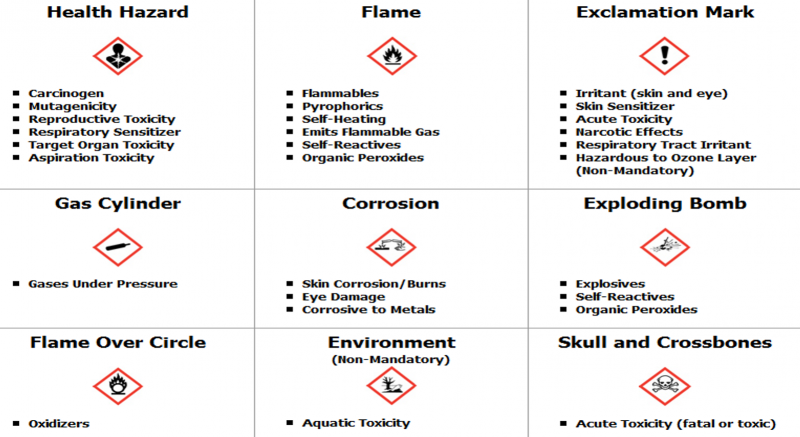
Chemistry
Hazard Communication Information
The Hazard Communication Standard (Federal Standard 29 CFR 1910.1200 or for Washington state WAC 296-901) also known as the "Right -to-Know" law enacted in 1985 sets forth the following requirements:
- It is the responsibility of the manufacturer of a material to determine what hazards are associated with the material, to prepare an SDS for the material, and to provide the SDS to any recipients of the material.
- It is the responsibility of an employer to provide SDSs and training in their interpretation to the employees. SDSs for hazardous materials must be readily available in the workplace.
- It is the responsibility of the employees to read and understand the SDSs of any chemicals used on the job.
How to Identify Hazardous Chemicals Under the Globally Harmonized System for Hazard Communication (GHS)
Background
In 2003, the United Nations (UN) adopted the Globally Harmonized System of Classification and Labeling of Chemicals (GHS). The GHS includes criteria for the classification of health, physical and environmental hazards, as well as specifying what information should be included on labels of hazardous chemicals as well as safety data sheets. In 2012, the Department of Labor: Occupational Safety and Health Administration (OSHA) adopted the GHS as the standard for Hazard Communication. Washington State also recognizes the GHS and the full standard can be found online here: WAC 296-901.
Hazard IdentificationHazardous Chemicals can easily be identified under the GHS be examining the labels of chemical containers. Containers must have the following six key label elements on primary containers:
- Product Identifier
- Signal Word
- Hazard Statement(s)
- Pictograms(s)
- Precautionary Statement(s)
- Name, address, telephone number of the chemical manufacturer, importer, or other responsible party
These six key label elements will alert any user to hazards present when using a hazardous chemical and the label elements correspond to information found on the chemical's Safety Data Sheet (SDS). Information on how to read an SDS is found below.
Secondary Container Labeling
The above key label elements apply to primary containers. Secondary containers and working containers such as beakers and flasks must contain at least the product identifier as it appears on the SDS.
Detailed information on key label elements is listed below.
- Signal Words
Signal words alert the reader to a relative potential hazard.
"Danger" - indicates a severe hazard
"Warning" - indicates a less severe hazard
- Hazard Statements
Hazard statements describe the nature of a hazardous product and the degree of the hazard associated with the product.
"Highly flammable liquid and vapor"
"Fatal if swallowed"
"Toxic if inhaled"
- Precautionary Statements
- Safety Data Sheet (SDS)
What is an SDS?
Safety Data Sheets (SDSs) are detailed informational documents which describe the physical and chemical properties of a hazardous chemical. These documents are prepared by the manufacturer of the chemical.
Where do I find SDSs?
In the Chemistry Department
Hard copies of SDSs for all chemicals in the Chemistry department are located in the Chemistry stockroom (Sci 303), in each research lab for lab specific chemicals, and at the SDS Workstation in the hall outside Sci 311. For a copy of the SDS - take the appropriate binder to the Chem office (Sci 302) and the secretary will make a copy. Do not remove the SDS from the binder.
On the Internet
Various SDS search methodologies links
An SDS is organized into 16 specific sections, which must include the following information in that section:
- Section 1. Identification
- Product identifier; recommended or restricted use; manufacturer’s information; emergency phone number
- Section 2. Hazard(s) identification
- All hazards associated with the chemical; required label elements; specific toxicity information
- Section 3. Composition/information on ingredients
- Chemical name; common name; Chemical Abstracts Service (CAS) number; trade secret claims
- Section 4. First-aid measures
- Description of necessary measures subdivided by route of exposure; most important symptoms/effects, acute and delayed; indication of immediate medical attention/special treatments if necessary
- Section 5. Fire-fighting measures
- Suitable (and unsuitable) extinguishing media; specific hazards arising from combustion of the chemical
- Section 6. Accidental release measures
- Personal precautions, protective equipment, and emergency methods; methods and materials for containment and clean up
- Section 7. Handling and storage
- Precautions for safe handling; conditions for safe storage, including any incompatibilities
- Section 8. Exposure controls/personal protection
- Permissible Exposure Limit (PEL), Threshold Limit Value (TLV), any other relevant exposure limits; appropriate engineering controls; personal protective equipment (PPE)
- Section 9. Physical and chemical properties
- All known chemical characteristics
- Section 10. Stability and reactivity
- Chemical stability; potentially hazardous reactions conditions to avoid such as static discharge or vibration; hazardous decomposition products
- Section 11. Toxicological information
- Information on the likely routes of exposure; symptoms related to toxicological characteristics; carcinogens
- Section 12. Ecological information (Non-mandatory)
- Ecotoxicity; persistence; bioaccumulative potential
- Section 13. Disposal considerations (Non-mandatory)
- Description of waste residues and information regarding safe handling; instructions for disposal of contaminated packaging
- Section 14. Transport information (Non-mandatory)
- Transport hazard classes; environmental hazards
- Section 15. Regulatory information (Non-mandatory)
- Safety, health, and environmental regulations specific to the product in question
- Section 16. Other information, including date of last preparation or last revision
- Date of SDS preparation or the last change to it
Where can I find additional help reading SDSs?
At CWU the following people's and their contact information will help you wtih safety data sheets
Name: Tony Brown
Position: Stockroom Manager
Room: Sci Rm 303
Phone: (509) 963-1303
Email: browna@cwu.edu
Name: Daniel Hall
Position: Safety Representative
Room: Sci Rm 315
Phone: (509) 963-1307
Emai: halld@cwu.edu
CWU News

CWU women’s rugby team earns six All-American selections
May 13, 2024
by University Relations

CWU Board of Trustees to Convene this week
May 13, 2024
by University Relations
Questions? Contact Us.
Chemistry
Science Building, Room 302